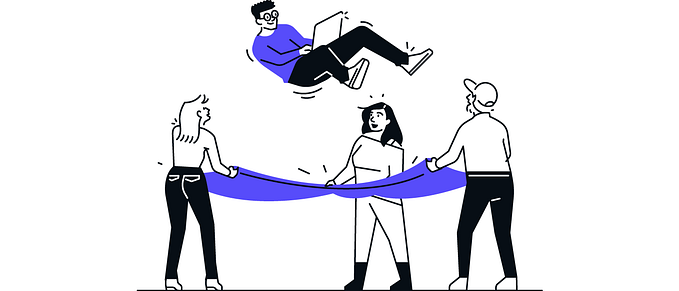Be a Pal, My Dudes
A guide to being an ally in the workplace

 So, we at Mule run a workshop to help women reduce the impact of gender bias in the workplace. A commonly asked question is something like “Why aren’t you running a workshop for men since they are the ones who have to change?” The short answer is that it’s a complex dynamic, and women have the most incentive to change it. Our approach is to help decrease the amount of effort overall since women in male-dominated workplaces are already putting in so much extra because of bias. If you want to change habits, start where there are already strong incentives for change.
So, we at Mule run a workshop to help women reduce the impact of gender bias in the workplace. A commonly asked question is something like “Why aren’t you running a workshop for men since they are the ones who have to change?” The short answer is that it’s a complex dynamic, and women have the most incentive to change it. Our approach is to help decrease the amount of effort overall since women in male-dominated workplaces are already putting in so much extra because of bias. If you want to change habits, start where there are already strong incentives for change.
The longer answer is that we’re working on it.
In the meantime, I know there are a lot of men out there right now with good intentions who want to help change things, but it’s not always clear which actions are most helpful. And asking the people who are already doing extra work to do the additional work of teaching you how to help them do less work is…annoying. This is true for anyone who has more privilege in any given situation. Do your part to make it easier.
We all know the right thing to do, it’s cultivating a habit of doing the right thing in the moment that is so hard.
So, based on what we’ve heard in our workshops, conversations with colleagues, and straight-up asking Twitter, here are a few very specific helpful actions you can take. Many of these you’ve probably heard before. If we keep repeating them, maybe they’ll stick. We all know the right thing to do, but it’s cultivating a habit of doing the right thing in the moment that is so hard.
(Note: This list is just a starting point, and I’ve focused on peer-level actions, not management. Thanks to everyone weighing in!)
Listen to women
This is fundamental on all levels. Listen to the individual woman who is talking to you. Assume she knows what she is talking about. Listen to the collective voices of women saying there is a problem. Stifle any urge to respond defensively. Don’t try to guess what they’re about to say. Just listen.
And don’t interrupt.
Create space for women to speak
The research suggests that, in groups, men tend to get and keep the floor more often than women, talk more often and for longer, interrupt more, and make different kinds of contributions, using language strategies that challenge, create and maintain status distinctions (i.e. they create and maintain asymmetrical alignments between themselves and interlocutors).
—Shari Kendall and Deborah Tannen, Gender and Language in the Workplace
When you are speaking, you can help just by getting to your point faster. This helps everyone, really.
For bonus points, start paying attention in meetings and listen for men using far more words than necessary. Logorrhea is not necessarily a conscious move, and it often comes from insecurity. Truly confident people are succinct.
Give credit to women publicly in front of other men
I am sure you’ve heard about the problem of men either taking credit for women’s ideas or wrongly attributing credit to a man. Don’t accept credit someone else deserves more. Again, this is often unconscious. That doesn’t make it OK.
Credit is not a scarce resource to the competent. You — yes, you — have an infinite supply to hand out. Look for opportunities to acknowledge and amplify and go wild. Being generous is fun. And if you start intentionally making an effort to notice the contributions of women, you’ll find plenty to call out.
In a meeting: “Beth, what you said just then was really good. Say it again.”
Walking to grab coffee with guy friends: “Ti said something yesterday that totally changed the way I see the problem we’re working on.”
Celebrating success: “We hit our goals and I want to give a shout-out to Sofia. Her work really pushed us over the top.”
Use inclusive language
Our common workplace language is so gendered we often don’t even see it. Consciously choosing more inclusive language is powerful.
Taking a moment to respect and include colleagues who aren’t in the historical default isn’t that hard. Gypsum mining is hard. So I don’t want to hear whining about typing more/different words into a text field or remembering to use the right pronouns. Instead of “Hey, guys!” say “Hey, team!” (or “Hey, colleagues!” or “Hey, folks!” or “Hey, friends!” or “Hey, y’all!” or “Hey, spuds!”).
It’s really easy to self-sort and end up unconsciously excluding people just because of the truly minuscule amount of extra effort required to do otherwise. Stop doing the easiest thing. It’s boring, anyway.
Make activities more inclusive
The thing about humans is that we love being exclusive. Think of how many products and services refer to being “exclusive” as a selling point. So, that must mean that anything inclusive is an inferior good. This is a lot of programming to overcome. But you can do it!
If you’re having a spontaneous conversation that turns into a potential decision, call a pause until others who should be part of it can join in. If you’re scheduling an important conversation or a panel or a conference, bring in different perspectives.
Socializing — everything from hallway small talk to launch parties — is a critical part of most jobs, and it is a minefield. Do whatever you can to make situations more welcoming. Expect that everyone has interests and obligations and risks that are different from yours and may not be obvious to you. To make up an extreme example: Not everyone is able or cares to go midnight bouldering with their coworkers. Seems obvious, right? For many people, drinks after work might as well be midnight bouldering.
Broaden topics of conversation (by asking questions and creating space).
And no tokenizing. When you invite people, listen to them and value them.
Check other men
If you witness another guy being sexist, rude, dismissive, or behaving in a way that makes the workplace harder for others, call him out. Again, you’ll need to put your antennae up for this. And it doesn’t have to be a big thing. Simply saying “Not cool” could be enough.
This is the only way behavioral norms will change — one interaction at a time.
If you notice a pattern of non-collaborative behavior there are various ways to handle it, from addressing it generally in a “Hey, let’s make sure we hear from everyone without interrupting” way to a private, side conversation with the wrongdoer.
This is the only way behavioral norms will change — one interaction at a time.
Bust your own stereotype
Deciding what to wear to work can be insanely complicated for women — a whole extra level of effort on top of whatever the job duties are. When there are relatively few women on a team, there is absolutely no way to dress “like everyone else” and just blend in. So it can be impossible to calibrate, especially in more casual cultures. I’ve heard from many women that this can be one of the most stressful parts of the job.
If you are part of a strong default work culture, you can use your privilege to expand the expected range of behavior and presentation. This will help create space for others who aren’t part of the default. And no, I am not telling you to appropriate other cultures or wear flip-flops on the shop floor.
I worked with a developer by the name of Jim Ray who offered an outstanding example of looking like no other “techie” I’ve ever met. He dressed sharp every single day and would code in French cuffs. Standing out can be scary at first, but consider the fact that for many people, standing out is not optional.
And personal style is just one facet. Think of other types of stereotype-busting you can do. If you’re a dad, take time off for childcare and talk about it (and OMG, do not call it “babysitting”). Make sure meetings have ample breaks. Admit that you don’t have all the answers. Bring in a tray of brownies that you baked for your team. So many possibilities!
Excelsior!
So much of this stuff comes down to caring, noticing, and doing a few small things differently. The result will be an environment in which everyone can do their best work, enjoy mutual respect, and learn from one another.
I hope this is the future we all want. If you want to check out the whole Twitter thread, it’s here and growing.







